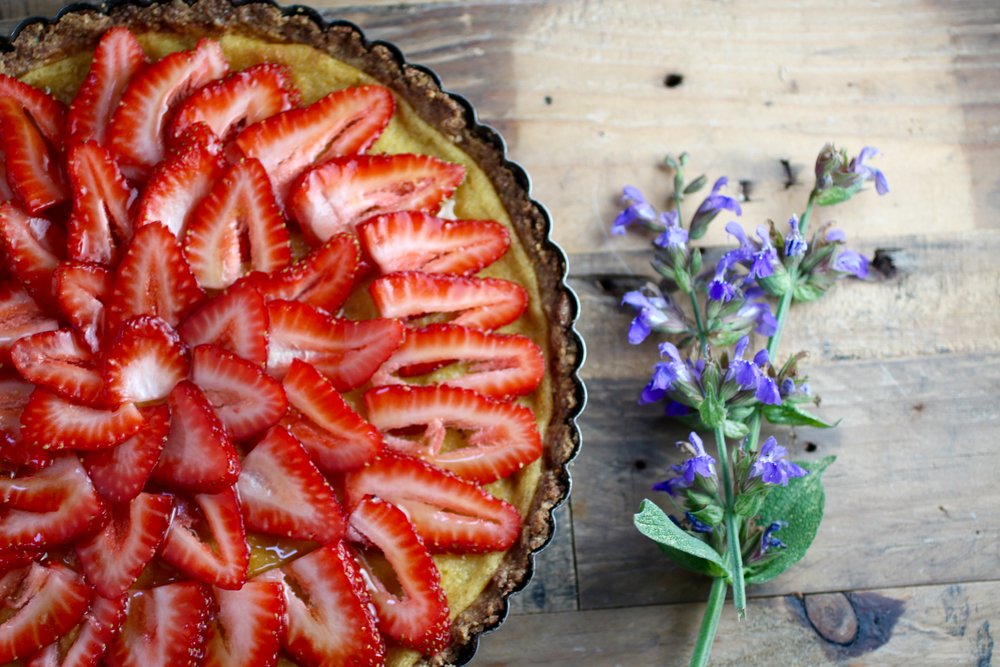Strawberry Mascarpone Tart with Lavender
Strangely, I have made this tart (or variations on this tart) several times and have never recorded the recipe - it is just that easy and forgiving! In the interest of posterity and the sharing of deliciousness, I decided to finally post the recipe to the blog.
As mentioned, this recipe is very forgiving so variations are accepted and encouraged, though the combo of cornmeal-strawberry-mascarpone-lavender should not be treated lightly. The cornmeal crust is a variation on a classic pâte sucrée that I use for almost every tart shell. I have also subbed the cornmeal for buckwheat, which is just as delightful, but a little darker/nuttier. Other variations include brown sugar in place of white, addition of different herbs and spices such as rosemary, cinnamon, or saffron, different fruit, etc. Again however, you might want to just stick to this very delicious combination! Makes one tart, about 6-8 servings.
Mascarpone tart awaiting strawberry slices.
7 tablespoons cold unsalted butter, plus more for greasing the tart pan, diced
1/2 cup plus 2 tablespoons all-purpose flour
1/2 cup cornmeal (medium-grind)
1/2 teaspoon plus one pinch salt (medium-grind), divided
2/3 cup granulated sugar, divided
2-3 tablespoons plain yogurt, cold milk, or cold water (I prefer yogurt for its tangy quality)
8 ounces mascarpone
1 large egg
1/2 vanilla bean pod scrapings
1/2 teaspoon vanilla extract
1 pint strawberries
1/4 cup lavender flowers (other edible flowers can be used, but lavender is very easy to find as it often grows wildly or is feral on roadsides)
Honey, for drizzling
To Prepare
Lightly grease the bottom and sides of an 8-inch or 9-inch tart pan. Set aside.Mix flour, cornmeal, 1/2 teaspoon salt, and 1/3 cup sugar and cut in butter. Using pastry blender, fork, or hands mix butter into flour mixture until the dough resembles small peas. Add yogurt, milk, or water and blend until dough sticks together when pressed, but is still crumbly.
Press dough into and up sides of pan, chill in refrigerator for 30 minutes. Preheat oven to 350 degrees F and bake for 15 minutes, until golden-brown. Remove from oven and allow to cool.
While tart shell is cooling, remove the tops from the strawberries and thinly slice. set aside.
Whisk mascarpone with remaining 1/3 cup sugar, egg, vanilla bean pod scrapings, vanilla extract, and pinch salt until combined. Once tart shell is completely cool, spread mascarpone evenly over shell and bake for 30-35 minutes, or until set. Tart will turn golden and may have some areas of browning and start to rise some - don't worry, that's what is supposed to happen!
Remove from oven and cool for 20-30 minutes. Top mascarpone with strawberries in overlapping concentric circles, starting with the largest strawberry slices around the outer edge and working your way in until the entire tart is covered with strawberries.
Top with lavender flowers and drizzle with honey. Serve at room temperature or cold.
Strawberries laid out in concentric circles - now just awaiting the lavender and honey!
Foraged Herbes de Provence
Sometimes, a blend of herbs is used so often that it is considered its own flavor. Herbes de Provence is such a mixture, typically including dried rosemary, lavender, and thyme, but it may also have other herbs common in the south of France such as oregano or marjoram.

What was the impetus for this combination and why do the flavors combine so well? Likely, not much thought went into what is now classic, but rather it was a “use what you have” scenario. One theory for successfully combining ingredients is that if ingredients share flavor compounds, which the Herbes de Provence ingredients, they will compliment each other. Although this hypothesis makes sense and is somewhat calming, as it gives us a succinct way to understand flavor combinations, it only really works in Western cuisine. In Eastern Asian cuisine on the other hand, recipes frequently avoid overlapping flavor compounds. The scientist in my wishes the theory was consistent for all foods, but the artist in me is inspired by the fact that opposites can attract.
This is more of a guide than a recipe, as it can be adapted to suit your needs and ingredient availability. We foraged our herbs on a hike in France, but that doesn’t mean you can't forage or purchase the same herbs from the U.S.! I highly recommended drying the herbs yourself, as dried herbs are often sitting on the shelf for very long periods of time and can be flavorless.
3 parts fresh rosemary, on the stem
3 parts fresh thyme, on the stem
1 part lavender, on the stem
Other Provençal herbs, as desired (marjoram, oregano, savory, etc.)
Allow herbs to dry by setting them apart from each other near sunlight and/or fresh air for 2-3 days. This may take longer if in a humid and/or cold climate.
Once herbs are completely dry, remove leaves from stems by running finger down spine into a bowl.

Crush herbs using a food processor or mortar and pestle to desired texture. I prefer herbs to be well, but not finely, crushed. Enjoy for up to a year.
Suggested uses: Herb-rolled chèvre (fresh or hot as in Chèvre Chaud salad), meat-rub, in olive oil for bread dipping, topping grilled vegetables.






